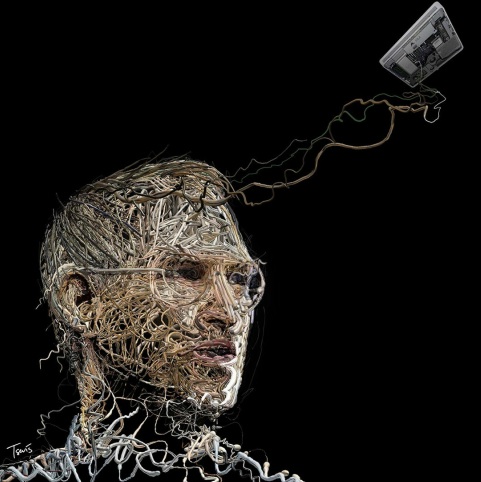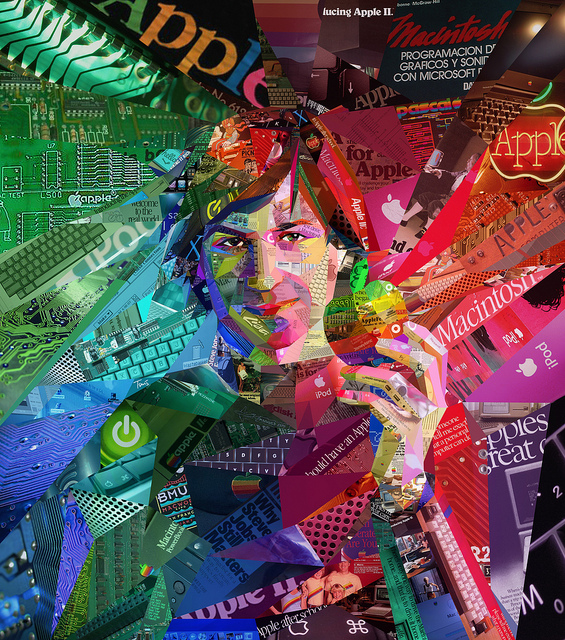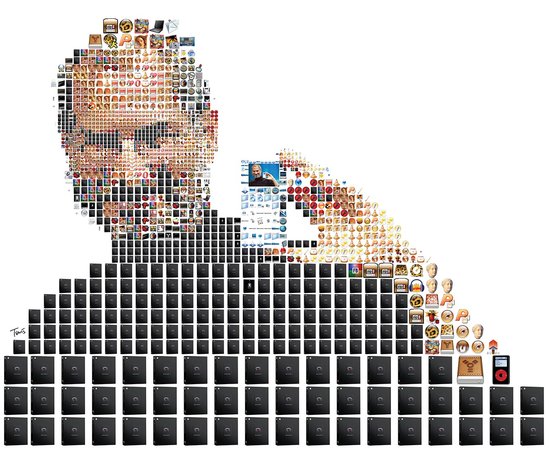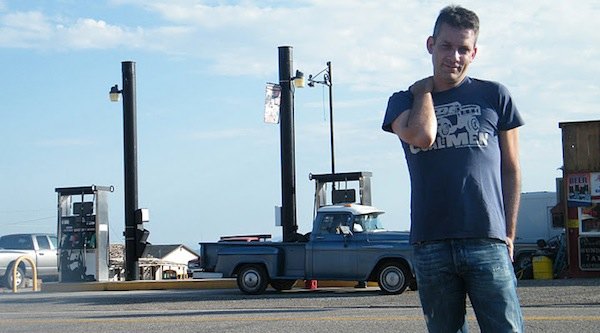
Lately, the only reason Greece would catch international media headlines is its financial tragedy. But there is some light emerging and it’s coming from art. Meet Charis Tsevis, the mosaics guru behind those iconic Steve Jobs portraits.
From the Wall Street Journal and the Los Angeles Times, to Fortune, and the Sunday Times, Tsevi’s mosaics fascinate audiences worldwide. His personal hero is no other than Steve Jobs. In fact, his stunning portrait with Steve’s face made from Apple gadgets was an ‘ultimate get well soon gesture’ when Apple’s chief executive was on indefinite medical leave.
Mr. Tsevis seems to be sharing a lot of common qualities with his personal hero. The relentless intensity and total commitment that he brings to his work, has a simple explanation: just like Steve Jobs did, he genuinely enjoys what he does. He’s foolish, he’s hungry and visual design is his daily bread.
And no, the award winning Tsevis is not based in New York or London. He’s still living and working in his hometown, Athens.
How did a young Greek designer based in Athens end up designing mosaic portraits that are already considered iconic for the biggest magazines in the world in the first place? How did it all get started?
It started many, many years ago. It was the love for visual complexity that fascinated me since the beginning of my design studies. So I guess that it’s no different to any other story of hard work.
You’ve spent the last five years creating mosaic portraits of Steve Jobs. Why are you so interested in Steve Jobs? What qualities about him did you admire the most?
Actually I spent many, many more. Steve Jobs was something like a personal hero to me for the past 30 years. I was following him since the late 80s. Back then, people used to think he was just an arrogant playboy or a lucky guy who had a genius friend. I recognized that there was a lot of contrast in his life, private and professional, but that it was this inherent contradiction of his was that fascinated me.To me, Steve Jobs was a visionary who was crazy enough to forsee what the future demanded and practical enough to create it. He was a tough person and at the same time a very fragile buddy. I had read every biography of his and every Apple history book and I wanted to understand the guy who traveled to India to find enlightenment before Apple or sleep under the Tuscan skies in San Gimignano after he was fired from Apple. I was also obsessed with the history of computing and most of all I was following the computer underground. I was amazed on how the West Coast culture was transforming the most advanced industry in the world.
In my vision, Jobs made history. It was the personal computer that made possible the fall of the Berlin Wall and made the world more open and free. And the person who could be the real leader of all that movement was Steve Jobs, even if back in the early 90’s he was almost irrelevant.
What do you think is his biggest legacy?
The human-centric approach to technology. The combination of liberal arts and technology, science and fun. This combination is something that I can totally identify with.
From stunning vintage portraits depicting Steve as a hippie in his youth, to the incredibly intricate mosaics portraying the late Steve, your portraits have been commissioned by the biggest magazines and newspapers in the world. Did you expect your work to have such an impact?
Certainly not! I was just experimenting with mosaics and I was using the image of a personal hero. I was doing that for years and I was surprised even with the popularity of my work between the Mac community on the internet. I have never imagined working professionally for that. The first time Fortune magazine asked me for a portrait of Steve Jobs I thought that some friend is messing with me! This approach was far too personal to actually believe that they were for real and wanted me to work for them! Obviously, Steve Jobs was a very strong brand that helped me boost my career.
Your portrait of Apple’s mastermind for Panorama, the best selling magazine in Italy, depicting Steve’s face made from i-stuff, is admittedly one of the most original visual portraits ever made. How did you come up with the idea and what technique did you use for the specific portrait?
It was a simple implementation of the Gestalt psychology principle “The whole is greater that the sum of the parts”. Most of the people when thinking of Steve Jobs think about products. But to me it’s something more than ephemeral products. It’s about culture. The Panorama covers were based on the idea of the “Black and White period” of Apple. The Art Director of the magazine challenged me with the idea of an all white portrait. I created the white first using all the white products of Apple. I have “shut down” the displays and emphasize on the industrial design. I was happy with the white but then I wanted to create a black version too in order for these portraits to be like twins. I did it before with the portraits for Fortune and I wanted to repeat it. For me Steve Jobs was a person of contrast. The black and white approach could communicate this contrast.

Each one of your Steve Jobs creations is totally different to the other with rather strong personalities. Would you share some info on the techniques you use?
I am asked too often about my technique. Some people believe there is a single formula, a series of clicks that can create a mosaic portrait but the truth is, a mosaic is so much more than that. Mosaics have been around for centuries. What always fascinated people in mosaics was that there is this dialogue between the parts and the whole. To me every image is a mosaic as it is nature. As you are zooming in you can discover more and more. So my technique is to build the right mosaic studying all its parameters. The grid, the size, the symmetry, the patterns, the rhythm. I am working with many software titles but mostly with Studio Artist a very powerful Mac Only tool developed by a Hawaiian guy called John Dalton. John had a long experience creating software synthesizers and he has implemented the same principles you can find in music in visual arts.
I have created my own series of scripts and my own tools using Studio Artist. But what you see as a final piece is not the outcome of just a series of clicks. It’s hours of work making changes and paying attention to details.
Which one of your Steve Jobs portraits is your favorite and why?
Very difficult to say. I love them all for different reasons. Mostly sentimental.
Is there a gadget Steve created you can’t live without?
I am not so attached with objects. I couldn’t live without Apple technology. But it’s not that I have a favorite gadget.
Did you know Steve personally?
I wish. I would really like to have a long drive with the guy, maybe going up to Yosemite and talk about life. But unfortunately this will remain a dream.
Did you consult Steve himself as you were preparing the mosaics? Did he make any changes?
No. Many friends encouraged me to write to him, to ask his opinion. I was too afraid to ask him anything. I was afraid that maybe he wouldn’t like my work…Then one day – about a year ago – I sent a simple email asking him exactly that: If he liked my portraits. I never got an answer. So I will never know. But you know what? It doesn’t really matter.
Have you been surprised by the outpouring of love all around the world since his passing?
Actually not. I thing he deserved that 100%.
Steve Jobs was neither a hardware engineer nor a software programmer and yet managed to create an empire and affect the lives of millions. Here in Greece the overqualified “700 a month generation” is rioting on a daily basis mainly because there’s no hope. What do you think should be done to change in this country so that the youth can move on?
Hmmm… That’s too difficult to answer. I really cannot find a simple solution. But if we learned something from Steve that would be to first inspire people. A nation that doesn’t believe cannot go ahead. Steve Jobs has transformed Apple returning to the roots of its values but at the same time fighting nostalgia and love of the glory days of the past. He made clear what the values are but also guided his team to the future. I think that this is what Greece and the rest of the world needs.
Depression and suicide rates have increased dramatically the past two years due to the crisis. Has the pessimistic feeling evident all over Athens affected your work? And how do you think art can become a motive power so that Greece can finally kill its demons?
I don’t know if it’s obvious or not but I am afraid it did. Greece is through a very tough period. You cannot be untouched by that. But I agree with you 100%. Art is a safe shelter and a guiding light. I am feeling very lucky that I can run to that shelter every day.
In a previous interview of yours you stated you are passionate about Gestalt psychology, in which the main rule is that the whole is greater than the sum of the parts and indeed this element of wholeness is evident all over your work. Do you think this concept of the whole being greater than the sum is lacking in Greece right now?
Absolutely. It’s always like that. But at the same time you can make magic when you change one part. So it would be a good idea to start also by fixing small parts. We need a start. Any start.
As a design professor in Athens you are surrounded by hopeful Greek designers. Do you see an impact of the crisis on graphic design’s evolution during the past couple of years?
Unfortunately yes. There is this feeling of hopelessness in our country right now. But at the same time I see people wanting to change things. I see people wanting to fight this and win their life, their country, their future.
Greece’s tragedy has led many young talents to migrate and look for a better future elsewhere. Have you ever thought of moving from Greece, say to New York or London?
Personally I am lucky enough to have found my wider audience and market outside Greece. There is no urgent need to leave Greece seeking for a job. Otherwise I would have to leave. I understand the people leaving. I love Greece but I am thinking of moving every single day but then I end up staying here every night. It’s strange. It’s somehow like we are all prisoners of our beautiful country.
Other than Steve Jobs you have made countless editorials and magazine covers. Amongst them is Barrack Obama, Michael Phelps, Marc Zuckerberg. Why have you chosen these three personalities?
Phelps and Zuckerberg weren’t chosen by me. Some media asked me to work for them. But I like both these guys. Especially after I worked for these portraits and I had to learn more about them. On the other side, Barack Obama is a person I really admire and believe. I was using his image and his ideas long before he became trendy. I believe he can do great things. I will still use him in my experimental work as he is still inspiring me. And now that he is facing real problems and real challenges much more than before.
Generally, I like to portrait positive people. I don’t want to create anything negative. If I don’t like someone I prefer not to have to work on his face.
There’s a constant nagging about the lack of true leaders in Europe. You have designed an Obama portrait but other than that we haven’t seen more politicians’ portraits. Why is that?
Because honestly, there is only one Obama! We desperately need many more like him.
Is there a contemporary politician from the European or even the Greek scene that you would like to design a portrait for and why?
Hmmm… Yes there is. I have thought of working on someone but I am not 100% convinced. So I let go. If you have any suggestions let me know!
Are there other people you’d love to have illustrated?
Of course. Too many actually. Nelson Mandela is another great leader I would like to illustrate. Then there are people from the world of science, sports, technology. The world is full of great people. It’s only tough when it comes to politicians.
What are you working on now?
I am working on a series of fine art pieces.
Where do you seek inspiration from and who are your favorite designers?
From everywhere. From nature, ethnic cultures, tradition, love, food…I have many favorite designers-too many actually. I could talk about my favourite designers for hours. If I had to chose just a few they would be within the circle of the gestalt influenced designers in Scuola Politecnica di Design in Milan during the early 90s like Nino Di Salvatore, Bruno Munari, Augusto Garau, Carlo Nangeroni, Vittorio Prina… Then there is John Maeda and his long list of students like Peter Cho. Then there are great ethnic schools like the Brazilians. I am also following the new APAC rising design scene. And of course my students. There is so much talent in these guys. Some of them are starting to really take off and I am extremely proud for them.
Did your parents encourage you to become an artist?
Yes. In many ways. They actually wanted me to become an artist in any profession. And at the same time a scientist in every art. My folks were like Steve Jobs before him.
Have you ever had moments when you felt like you wouldn’t financially survive as an artist?
Sure. Many times. Almost every day. I might be considered successful but it’s hard to stay healthy in this profession. Yet I couldn’t imagine myself of doing anything else. You don’t only work for the money. And if you are not happy with what you are doing you cannot make money. At least I cannot.
Amid the biggest financial crisis Greece has faced after the Junta collapsed back in 1974, what would you advice a teenager who wants to become a visual artist but is worried that he/she is going to end up unemployed?
I think that despite all the problems design is a great profession that could lead to many different places. It’s so nice to wake up every morning to create things.I guess I would simply repeat Steve’s words about following his heart: “There is no reason not to do that. If you stay hungry and foolish you will find your way”.
See all the latest news from Greece and the world at Greekreporter.com. Contact our newsroom to report an update or send your story, photos and videos. Follow GR on Google News and subscribe here to our daily email!






